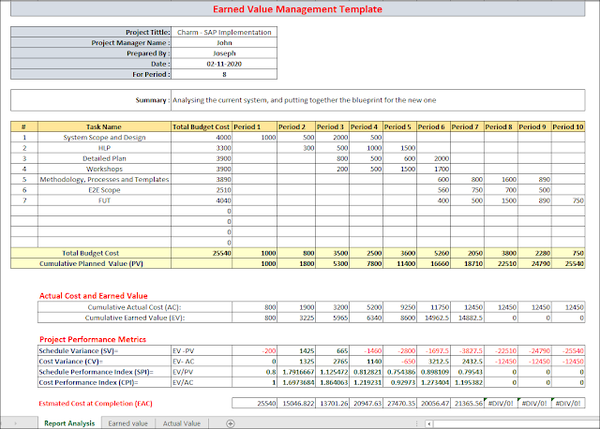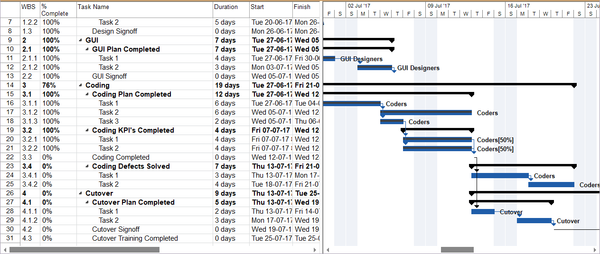Earned Value Management - Understanding The Main Calculations And Formulas
Earned Value Management (EVM)
Earned Value Management (EVM) is a strategy for project managers to use to define and quantify the performance of a project. Systematic in nature, this project management process is helpful for uncovering project variances by comparing work performed vs. work planned. Used to support schedule and cost controls, EVM is helpful for forecasting and planning.

Earned Value Management Template
Calculating the earned value of any work performed is useful because it provides project managers a quantifiable means for determining when corrective action should be taken.
What Is Earned Value Management?
Good planning is a hallmark of success. However, once a project starts, it can be difficult to evaluate where you are and even more difficult to course-correct if you veer too far off track. Setting the course is an important first step. But what comes next? How do you know if you are actually headed in the right direction?
You’ll know if your plans are sound when you move from planning to execution, and your plans become concrete actions. This happens during the execution phase when planning becomes a reality. As your project takes flight, you need a measure to assess your progress against your original plan so that you know if you should proceed or course-correct and adjust your plan.
That’s where earned value management (EVM) comes into play. EVM provides a measure of project performance and progress. Employing this strategy allows project managers to define and quantify the performance of a project. Systematic in nature, this is a key part of the project management process to uncover project variances by comparing work performed vs. work planned.
Calculating the earned value of any work performed is also useful because it provides project managers a quantifiable means for determining when corrective action should be taken. Used to support schedule and cost controls, EVM is beneficial for forecasting and planning.
Understanding Calculations For Earned Value Management
Earned Value calculates project status based on the perspectives of time or schedule and cost. Earned value analysis allows the project manager to have a clear, measurable indicator of where the project is about schedule and budget against project baselines.
Earned Value is important because while a project's progress may be evaluated as ahead or behind schedule and over or under budget, there are nuances to consider. Knowing if you are ahead on timing, but spending more than was budgeted, or running behind schedule, but spending less than projected can help with decision making.
Budget At Completion (BAC)
BAC is the project budget. For more complex projects, it is the sum of all budgets involved.
Planned Value (PV), Or Budgeted Cost Of The Work Scheduled (BCWS)
Planned value is equivalent to the budget allocated to the project’s efforts (scheduled work) exclusive of the management reserve. It is useful because it denotes the amount of work that should be completed at a given point in time based on the project plan and is derived by measuring planned work completed at a point in time.
- PV = Planned % complete * BAC
Earned Value (EV), Or Budgeted Cost Of The Work Performed (BCWP)
The earned value details the quantity of work completed during a specific time and is derived by measuring actual work completed at a given time according to the schedule.
- Actual % complete * BAC
Actual Cost (AC), Or Actual Cost Of Work Performed (ACWP)
The actual cost is the cost that has been expended for work performed during a specific time period.
- The total of all costs associated with the work performed for the given period.
Cost Variance (CV)
Cost variance is the delta between projected and actual spending. It is derived by subtracting actual cost from earned value.
- CV = EV - AC
Schedule Variance (SV)
Schedule variance is a formula that highlights the delta between plan and actual. It is expressed as the delta between the earned value and the planned value.
- SV = EV - PV
Cost Performance Index (CPI)
Cost Performance Index is a ratio of the earned value to actual cost.
- CPI = EV / AC
Schedule Performance Index (SPI)
Schedule Performance Index is the ratio of earned value to planned value and indicates whether the project is meeting scheduled expectations.
- SPI = EV / PV
Estimate At Completion (EAC)
Estimate at completion is the projected total cost of completing all work.
- EAC = BAC / CPI – If the CPI is projected to be the same for the remainder of the project, the EAC can be calculated using this formula.
- EAC = AC + BAC - EV – If the future work is accomplished at a planned rate, the EAC can be calculated using this formula.
- EAC = AC + Bottom-Up ETC – If the initial plan is no longer valid, the EAC can be calculated using this formula.
- EAC = AC + (BAC - EV ) / (CPI * SPI ) – If both the CPI and SPI influences the remaining work, the EAC can be calculated using this formula.
Estimate To Complete (ETC)
The estimate to complete is the projected cost to finish all the remaining work. Projections are based on past performance.
- ETC = EAC - AC – Assuming that the work is proceeding to plan, the cost of completing the remaining authorized work can be calculated using this formula.
Variance At Completion (VAC)
Variance at completion is the projection of the budget deficit or surplus expressed as a delta between the budget at completion and the estimate at completion.
- VAC = BAC - EAC
To Complete Performance Index (TCPI)
The performance index describes the performance that must be achieved to meet the financial or schedule goals and is expressed as a cost ratio to finish the outstanding work to the budget available.
- TCPI = BAC - EV / BAC - AC – The efficiency must be maintained to complete to plan.
- TCPI = BAC - EV / EAC - AC – The efficiency must be maintained to complete the current EAC.
Summary Of EVM Formulas :
|
Symbol |
Name |
Formula |
Description |
Interpretation of Result |
|---|---|---|---|---|
|
Inputs |
||||
| PV |
Planned Value | The value of the portion of the task scheduled to have been completed | ||
| EV |
Earned Value | The value of the portion of the task actually completed | ||
| AC |
Actual Cost | The actual cost of the task to date | ||
| BAC |
Budget at Completion | The total overall project budget (planned) | ||
|
Basic Outputs |
||||
| SV |
Schedule Variance | SV = EV – PV |
The amount that the task is ahead or behind schedule, expressed as a task value |
SV < 0 = behind schedule SV > 0 = ahead of schedule |
| SPI |
Schedule Performance Index | SPI = EV/PV |
The amount that the task is ahead or behind schedule, expressed as a percentage of the task |
SPI < 1 = behind schedule SPI > 1 = ahead of schedule |
| CV |
Cost Variance | CV = EV – AC |
The budget variance for a task, expressed as a task value |
CV < 0 = over budget CV > 0 = under budget |
| CPI |
Cost Performance Index | CPI = EV/AC |
The schedule variance for a task, expressed as a percentage of the task |
CPI < 1 = over budget CPI > 1 = under budget |
|
Complex Outputs |
||||
| EAC |
Estimate at Completion | EAC = BAC/CPI EAC = AC + (BAC – EV) EAC = AC + [(BAC – EV)/(SPI x CPI)] EAC = AC + ETC |
The estimated project budget at the end of the project, given the current project budget status | |
| ETC |
Estimate to Complete | ETC = EAC – AC ETC = new estimate |
The projected cost to finish the project | |
| VAC |
Variance at Completion | VAC = BAC – EAC |
The projected cost variance at the end of the project, given the current project status |
VAC < 0 = over budget VAC > 0 = under budget |
| TCPI |
To Complete Performance Index | TCPI = (BAC – EV) / (BAC – AC) TCPI = (BAC – EV) / (EAC – AC) |
The CPI required to complete the project on budget |
TCPI < 1 = under budget TCPI > 1 = over budget |
Why You Need An EVM For Every Project?

Earned Value Analysis
As noted above, EVM is beneficial for managing and controlling projects. It should be highlighted, though, that while it is a solid part of good project management, it does have some issues. Relying solely on EVM is never a good idea because the formulas measure a single objective data point, and the true earned value of any given project can change quickly.
For this reason, EVM should be considered a safety measure and the data taken as part of the overall project assessment. Also, because of the frequency with which changes may occur, it is important to review calculations once or twice a month, or even more if your project moves quickly.
It’s also important to consider that EVM does not allow for a view of customer satisfaction or project quality. Projects are not successful simply because they are on time and under budget. Other considerations must occur. Customer happiness is a key measure that should be reviewed in conjunction with schedules and budgets.
Finally, EVM is only as good as the data provided. As with any calculations, the principle of GIGO (garbage in, garbage out) applies. If the data that goes into the calculations is ‘garbage’ (i.e., bad data), then your EVM will not be a true reflection of project performance. That’s why it is essential to properly manage your data throughout the project.
Conclusion
Earned value is one of the more effective methodologies for evaluating overall project performance because of its ability to quantify scope, scheduling, and costing information to the various constituents and project stakeholders. And while some may express concern that it is a time-consuming activity, the reality is that it is actually simple to implement with a properly prepared project plan. The key to success is a sound work breakdown structure (WBS).
Proper application of the earned value formula and effective earned value analysis is a key driver to effective project management. To learn more, contact us.





Leave a comment